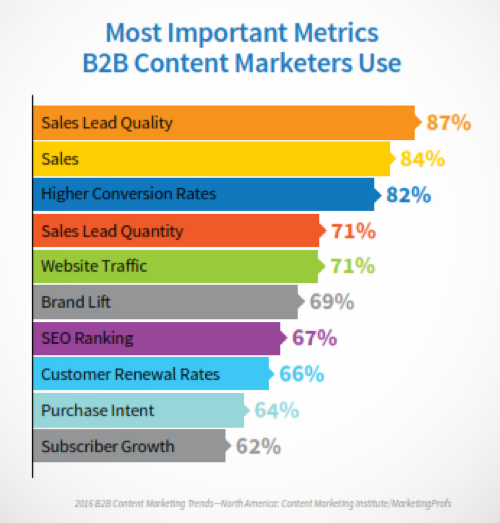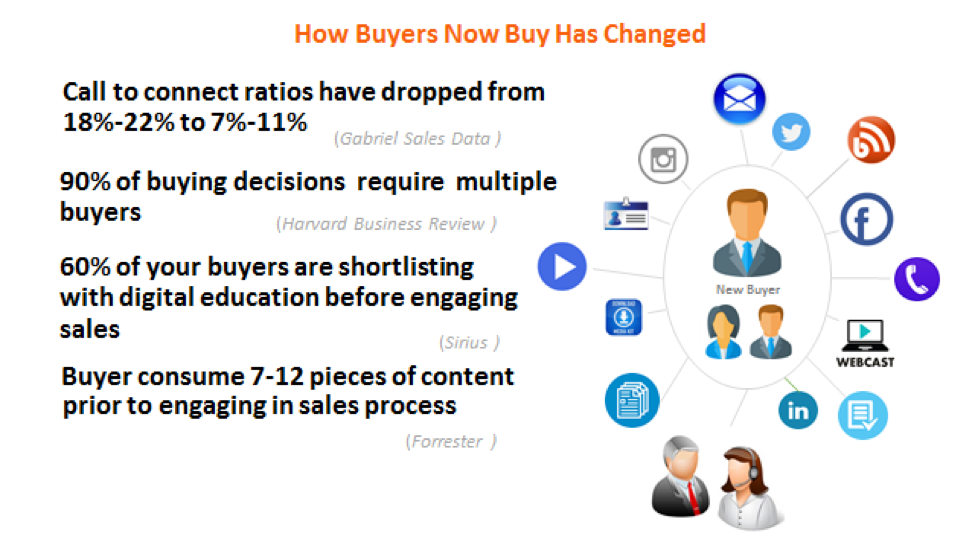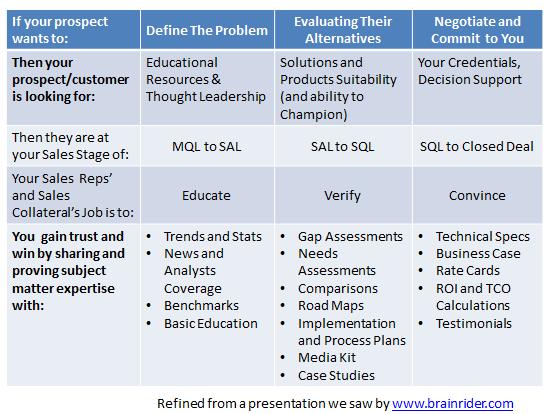by gabriel_sales | Oct 24, 2016
Content is now a critical piece of the puzzle to drive sales conversations for your business development rep. In fact, buyers now typically engage with 7-12 pieces of content prior to engaging with a sales rep, and they continue to engage with content as they make their purchase decision. So you need to support your sales professionals with the following content to ensure maximum success. This is even more important when you are involved in B2B sales or B2B outsourced sales. Below is a table that details the type of content your sales reps will need to help move deals forward.

Prove You Understand and Empathize with Your Buyers’ Needs
When you are developing your buyer’s interest, you need thought-leadership content. This content takes the shape of blog posts, checklists, and short headshot video clips that are educational and easy to consume. Keep these short and easy to digest in two to three minutes.
Outsourced Sales Engagement
As a buyer starts to engage, you need to make it easy for them to understand your solution. If you are just getting started, you don’t need to break the bank creating this content. We find that most companies have the features and benefits content they need on their website already. So after most content audits, that we offer as part of our strategy consulting, we typically only recommend:
- A short animated power point presentation converted into a succinct video overview
- Video demo screencast of the product or solution
- Organized microsites that aggregate your thought leadership and solution oriented videos that make it easy for the buyer to buy.
Finally, we find that most companies have the content they need to convince clients to buy covered. Typically this content is found in existing PowerPoint decks, proposals, RFPs, and contracts. Or for professional services firms, it is found in the deliverables. In some cases, you may want to simply consider digitizing some of this content and making it accessible online.
Summary
As a B2B outsourced sales company, we are committed to supporting our business development reps with:
- Content that supports your B2B outsourced sales process
- The ability to score client engagement with that content to help you score and prioritize leads
As you can see from the content we described above creating this content does not need to be overwhelming. For a quick examples you can check out what we are talking about by checking out our own:
Sales Ready Leads Program
Tradeshow Support Package
It simply requires authentic thought leadership that is professionally produced (not over-produced). We find that we can typically create the content we need to be successful as a B2B outsourced sales company with a 1 to 2 day onsite content workshop. If you think we can help we make evaluating that for yourself easy. You can get started with a free assessment, and you can start that process by contacting us today.
by Carol Springer | Jun 30, 2016
If you missed it, the 2016 Digital Summit in Denver took place June 15-16, and it was great! The vendors told me this was the largest Digital Summit on the west side of the Mississippi (yes, larger than the Los Angeles event). #DSDEN16 brought together hundreds of companies to share ideas and discuss the trends in digital marketing. After a bit of reflection, here are a few major takeaways worth sharing.
Community
Denver is a booming area for the Millennial generation, and the success of businesses here was epitomized at the Digital Summit. It was perfect weather, everyone was ecstatic, and the flow of ideas and discussions brought important strategies to the forefront of everyone’s mind. Several attendees stated of all the Digital Summit’s they’ve attended, this was one of the largest. Relative to where you are, anyone in this field should invest in going to the Digital Summit next year.
Mediums for Marketing
The big takeaways were video and social – as one “socialite”, @kirill_kniazev, stated in 140: #snapchat – do, #email – still good, #seo – great ROI, #mobile – more important than ever, create experiences, stories.
Snapchat is currently the hot social media app, and there was plenty of discussion around how to implement it within marketing strategies. This app is the catalyst for a shift in video marketing, making the norm quantity over quality. Snapchat allows for instant video, which means instant marketing. Now anyone can record and quickly watch videos from their phones. So while the quality is not on a professional level, sharing it is much quicker since the content has to be efficiently put into ten seconds. We see this as a must for targeting Millennials in the consumer space. In the B2B Marketing world, however, it may be awhile. The social winners for B2B sales and marketing are still LinkedIn and Twitter.
Marketing Automation
There was some surprise at the conference – the acceptance of marketing automation and how few in the sales team actually use the tools. Even when talking to sales reps from the marketing automation vendors, they do not use the tools themselves for sending emails. It is an underutilization of the amazing technology that many companies are paying 1000’s of dollars for every month. For implementation of marketing automation for sales, take a look at our recent post.
The Denver Digital Summit was educational, fun and entertaining. Thank you #AskGaryVee for inspiring my team, and see you there next year!
by Glen Springer | Oct 21, 2015
 This is the first blog in a five part series discussing how to increase B2B sales volume and how you can adjust your B2B lead generation, demand generation, and sales tactics to potentially double your revenue growth in the next 18 months.
This is the first blog in a five part series discussing how to increase B2B sales volume and how you can adjust your B2B lead generation, demand generation, and sales tactics to potentially double your revenue growth in the next 18 months.
This series discusses the shift in B2B sales (hint: buyers don’t buy the way they used to), the impact this change may have on your current business and approach, the growing importance of the role marketers must play in your sales process, and how you can turn this knowledge into a significant B2B sales and lead generation advantage.
There is a need to execute B2B sales and demand generation in a new manner. A recent study conducted by Adam Needles showed that companies that have embraced the concept of “selling to buyers the way they want to be sold” have seen a 157% increase in revenue over the past two years.
Only 10% of companies in the market have accomplished a successful adoption of this new paradigm according to Forrester Research, providing an opportunity to take advantage of your competitor’s unawareness. That same study suggests that a Fortune 2000 competitor will take 18 months and twice the expense to shift their culture due to resistance inherent in larger organizations.
The Shift: The Buyer (Not the Seller) Now Controls the Sales Process
Unless you’ve been MIA for the last ten years, you know that it is increasingly more difficult to get your buyer on the phone (our connection ratios have dropped from 18%-21% to 6%-11% over the past 2 years). Additionally, we are all aware that the sales cycle has increased between 1.5X-2X (that can be months, quarters, or even a calendar year depending on your sales cycle). This is all due to the buyer having taken control of the sales process and the abundance of information available. This simple fact is one thing you need to keep top of mind throughout this series and your sales execution.
Why Buyers are More Risk Adverse
It’s 2015, not 2006 anymore. The stock market fluctuates daily, R&D budgets are slashed regularly, and both real and imagined geopolitical and domestic issues are exacerbated by a rapidly increasing news cycle. Fewer aspects of the economy and business are perceived to be within our control which leads to tighter budget controllers who are more focused on mitigating this increased risk. Buyers have been forced to be smarter and more cautious with how they spend.
More People are Involved in the Buying Process
Since 2009, more decision makers are involved in the buying process (there is safety in making group decisions). According to a MarketingSherpa study, there are typically three people involved in transactions of 25K$-100K$ and anywhere from four to eight decision makers involved in deals over 100K$. Additionally, according to the Harvard Business Review, 90% of buying decisions now require input from both the technical expert and the business expert. What this has led to is the need for your team to educate and sell to more people with increasingly different needs.
SaaS, Telco, and Apple (to name a few) Have Transformed the B2B Sales Experience into a Consumer Sales Experience for All
SaaS companies have done a fantastic job converting the B2B sale into a consumer purchase experience. Now a buyer can come to a website, find the products they are interested in, conduct additional research, and in some cases just plug in the corporate credit card. In most cases, buyers can avoid speaking to a sales rep altogether, unless they make the conscious decision to be “sold.” Coupled with the fact that buyers feel more comfortable making large purchases due to the abundance of information available on the web, buyers are becoming more and more comfortable making these decisions without consulting a sales rep.
Consider how you purchase your home media now: I personally managed to bundle phone service, internet, cable television, and a sports package while layering in Netflix and Hulu streaming through a Blue Ray player and my kid’s Wii without ever speaking to a “sales person” other than to schedule installation. For another example, look at the experience provided by Apple retail locations. The “sales reps” greet you, allow you to play with the technology, have you request assistance when you are ready to buy, and they pull out their iPhone to conduct a $500-$2K transaction. B2B sales and marketing teams have had the bar raised and need to strive to improve the ease of education wherever possible.
Digital Sales Content = Critical
YouTube, Webcasts, Podcasting, Twitter, and Facebook are all household names which implies they have a long-standing history. However they have only been truly prominent for several years, and serious adoption in the B2B sale is less than a couple years old. The average buyer now digests 12 pieces of digital content on average before they purchase (up from five in 2011) and this trend is expected to continue.
Similar to SaaS sales and other technologies we discussed above, consider how your personal network consumes “entertainment” media. Just a few nights ago I looked around my living room and my wife was on her iPhone posting videos of our kids for the grandparents on Facebook, while simultaneously catching up on twitter. My son was on the iPad checking out MLB stats and my daughter was self-publishing a “picture-book” on the desktop while I was watching an NFL game (while DVRing Breaking Bad) and flipping through the Sunday New York Times on my iPhone. Did I mention I was also pulling a Google Analytics report for an upcoming meeting that compared mobile traffic during a time period in 2011 vs. 2012 (see below)?

Mobile Traffic Oct 2012
As consumers we are accustomed to digesting content where we want to and when we want to. We are consuming across platforms and mixing our consumption of entertainment and work-related content throughout the day. It’s easy – we feel entitled and we feel educated. This same philosophy must be applied to how you sell to your B2B buyer. They should be able to purchase your solution when they want to, and in the manner they desire, whether that be on Monday morning or Sunday evening.
The bottom line is simple: you need digital content!
You need to share it effectively and deliver your message in multiple formats so your buyers can educate and buy on their schedule, not yours. Remember, there are more and more buyers involved in the process that will want to digest specific material on their own time.
Meet the Buyer Where They Are in Their Buying Cycle – Don’t Force Them into Your Sales Cycle!
Inbound leads are coming in at earlier stages of the buying cycle when buyers are still in the education phase. This means your initial job as a sales and marketing team is to educate first, helping the buyer before you “sell” to them. This is tricky because it can increase your costs if you are overinvesting in selling to buyers that are not ready to transact. The flip side, which is potentially more daunting, is that we are now seeing 25% of buyers make their purchase decision after self-education and short listing online (Sirius, 2012). This means your team needs to act quickly and decipher where a buyer is in the buying cycle so they can be treated appropriately.
If you sell too hard, too early we know that:
- 70% of leads are passed to Sales Reps before they are ready to engage (MarketingSherpa, 2012)
- 80% of mishandled leads will buy from a competitor (Forrester, 2011)
If you get it right we know that:
- Well-nurtured leads close 23% faster and result in 40% more revenue (Aberdeen, 2012)
Summary
What is happening right now is not a small shift. It is a fundamental transformation that was the promise of an interconnected world after the internet first reared its head 30 years ago. In the last two years, this shift has accelerated dramatically. Since the birth of modern banking during the Renaissance, the majority of transactions have been driven by a seller-buyer relationship. The seller had information they shared with the buyer, and the buyer made a purchase. What we are experiencing now are the final stages of this dramatic shift that has been slowly taking place right underneath our noses since Google first organized the internet for immediate access. The buyer expects and desires to make a purchase without the intervention of sales whenever possible. They expect honest and authentic information, and demand it now. If you are not prepared to do this for your buyer (making the buying process fast, easy, and not sales-rep dependent) and your competitor is, you will lose.
To learn the impact this cultural shift has on your own sales and marketing culture, please check out the next blog in this series for things to consider as you ponder the looming question: What does all of this mean for your business?
If all of this seems a bit daunting, you can also check out our Sell Smarter, Sell Faster Whitepaper to learn more about short term tactics you can implement with your team right now.






 This is the first blog in a five part series discussing how to increase B2B sales volume and how you can adjust your B2B lead generation, demand generation, and sales tactics to potentially double your revenue growth in the next 18 months.
This is the first blog in a five part series discussing how to increase B2B sales volume and how you can adjust your B2B lead generation, demand generation, and sales tactics to potentially double your revenue growth in the next 18 months.
